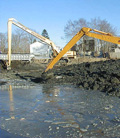Water: Contaminated Sediments
How to Protect








What is government doing to protect sediment quality?
No single agency is completely responsible for addressing the problem of contaminated sediments. More than 10 federal laws give EPA, the U.S. Army Corps of Engineers, NOAA, and other federal, state, and tribal agencies authority to address sediment quality issues.
What laws address sediment quality issues?
Some of the most important sources of sediment quality actions are the Clean Water Act and the Comprehensive Environmental Response Compensation and Liability Act, which established the Superfund program. Other relevant statutes include the National Environmental Policy Act; the Clean Air Act; the Coastal Zone Management Act; the Marine Protection, Research, and Sanctuaries Act; and the Great Lakes Critical Programs Act of 1990.
How do these laws address sediment quality?
- By identifying areas contaminated with chemicals.
- By restricting or eliminating further discharge of pollutants into water bodies.
- By implementing a remediation strategy that will most effectively reduce the risk associated with the contaminated sediment.
Solving the Problem
The first step in solving the problem of contaminated sediments is understanding that they present risks to public health and to the environment. Just as water quality has been a major concern for the past 30 years, sediment quality needs to become a priority as well.
The second step is preventing the discharge of more toxic contaminants into sediments. The government, private sector and the public can work together to protect and improve water quality by preventing toxic substances from entering the waterways. One piece of good news is that sediments closer to the surface of a water body generally have fewer contaminants than do deeper sediments. This suggests that discharges of toxics have dropped over the past decade or two.
In the third step, federal, state, and local government, the regulated community, environmental advocacy groups, and interested members of the public work together to identify all existing problem areas. Biological and chemical tests are run to determine how widespread and serious the contamination is at each site. Based on the results, priorities can be set for sediment management.
More Information
- Methods for Assessing the Chronic Toxicity of Marine and Estuarine Sediment-associated Contaminants with the Amphipod Leptocheirus plumulosus, First Edition (2001)
- Aquatic Ecosystem Health and Management Society

- Minnesota Pollution Control Agency - Contaminated Sediments

- Wisconsin's Contaminated Sediment Program

- Los Angeles Basin Contaminated Sediments Task Force

- Washington Department of Ecology Sediment Management Program

- Methods for Measuring the Toxicity and Bioaccumulation of Sediment-associated Contaminants with Freshwater Invertebrates - Second Edition (2000)
- Moving Mud: Remediating Great Lakes Contaminated Sediments (1997)
- EPA's Contaminated Sediment Management Strategy (1998)
- Realizing Remediation: A Summary of Contaminated Sediment Remediation Activities in the Great Lakes Basin (1998)
- Sediment Management Work Group

- European Sediment Research Network

